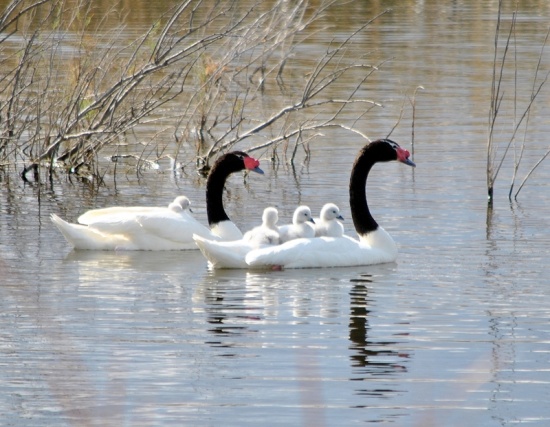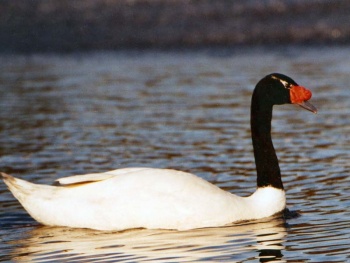(→External Links: Combined English and scientific names. Subtracted "Black Swan" from results.) |
|||
| (20 intermediate revisions by 5 users not shown) | |||
| Line 1: | Line 1: | ||
| − | [[Image: | + | [[Image:DSC 01576.JPG|thumb|550px|right|Adults with chicks<br />Photo © by {{user|Julian+Tocce|Julian Tocce}}<br />Lago Pellegrini, Río Negro, Patagonia, [[Argentina]], 10 October 2015]] |
| − | ;[[:Category:Cygnus|Cygnus]] | + | ;[[:Category:Cygnus|Cygnus]] melancoryphus |
==Identification== | ==Identification== | ||
| − | Males - 115-140 cm; females - 102-124 cm | + | Males - 115-140 cm (45½-55 in); females - 102-124 cm (40- 49 in)<br /> |
| + | *White body | ||
| + | *Black neck and head | ||
| + | *Greyish bill | ||
| + | *Red knob near base of bill | ||
| + | *White stripe behind eye | ||
| + | '''Cygnet''' - Plumage light grey, bill and feet black. | ||
| + | [[Image:Cisne de cuello negro.jpg|thumb|350px|right|Adult in flight<br />Photo © by {{user|Rodrigo+Reyes|Rodrigo Reyes}}<br /> El Yali National Reserve, Central [[Chile]], 2 June 2007]] | ||
| + | |||
==Distribution== | ==Distribution== | ||
| − | [[ | + | [[South America]]: found in [[Brazil]], [[Chile]], [[Argentina]], [[Tierra del Fuego]] and the [[Falkland Islands]]. |
==Taxonomy== | ==Taxonomy== | ||
| − | + | This is a [[Dictionary_M-O#M|monotypic]] species<sup>[[#References|[1]]]</sup>. <br />Formerly placed in the monospecific genus ''Sthenelides''. The specific name is sometimes misspelled ''melanocorypha'', e.g. by HBW, Sibley & Monroe and others. The change to ''melancoryphus'' was necessitated for gender agreement when the species was moved to ''Cygnus'' but ''melanocoryphus'' was used by Clements until the 2007 revision of their sixth edition and that misspelling is common in older publications. | |
| + | |||
==Habitat== | ==Habitat== | ||
| + | [[Image:Black-necked_Swan.jpg|thumb|350px|right|Photo © by {{user|Fritz73|Fritz73}}<br />[[Costanera Sur Ecological Reserve]], Buenos Aires, [[Argentina]], 2003]] | ||
Freshwater marshes, lagoon and lake shores. | Freshwater marshes, lagoon and lake shores. | ||
==Behaviour== | ==Behaviour== | ||
| − | |||
| − | The diet | + | ====Breeding==== |
| + | Breeds from July to August and mates for life. The nest is a large mound of vegetation usually in reed-beds close to the water's edge. The clutch consists of four to seven eggs incubated by the female. | ||
| + | ====Diet==== | ||
| + | The diet is primarily aquatic vegetation but they also eat insects and fish spawn. They occasionally graze on land foraging on terrestrial plants. | ||
| + | ====Vocalisations==== | ||
| + | [[Image:Black-necked Swan Immature.jpg|thumb|350px|right|Immature<br />Photo © by {{user|Luis+R|Luis R}}<br />Bicentennial Park, Santiago, [[Chile]], February 2018]] | ||
| + | Usually silent but when alarmed may give a series of soft, musical whistling notes especially during flight. | ||
| + | ====Movements==== | ||
| + | Resident throughout most of its range, but some of the southernmost populations are migratory. Occasionally wanders considerable distances. | ||
| + | |||
| + | ==References== | ||
| + | #{{Ref-Clements6thAug18}}#[https://avibase.bsc-eoc.org/species.jsp?lang=EN&avibaseid=B8C652E6EB81E01F Avibase] | ||
| + | #Wikipedia contributors. (2018, August 22). Black-necked swan. In Wikipedia, The Free Encyclopedia. Retrieved 09:38, January 21, 2019, from https://en.wikipedia.org/w/index.php?title=Black-necked_swan&oldid=856019686 | ||
| + | #Carboneras, C. & Kirwan, G.M. (2019). Black-necked Swan (''Cygnus melancoryphus''). In: del Hoyo, J., Elliott, A., Sargatal, J., Christie, D.A. & de Juana, E. (eds.). Handbook of the Birds of the World Alive. Lynx Edicions, Barcelona. (retrieved from https://www.hbw.com/node/52805 on 21 January 2019 | ||
| + | #Black-necked Swan (''Cygnus melancoryphus''), In Neotropical Birds Online (T. S. Schulenberg, Editor). Cornell Lab of Ornithology, Ithaca, NY, USA. retrieved from Neotropical Birds Online: https://neotropical.birds.cornell.edu/Species-Account/nb/species/blnswa2 | ||
| + | {{ref}} | ||
| + | |||
==External Links== | ==External Links== | ||
| − | {{GSearch|Cygnus | + | {{GSearch|"Cygnus melancoryphus" {{!}} "Black-necked Swan" -"Black Swan" }} |
| + | {{GS-checked}}1 | ||
[[Category:Birds]][[Category:Cygnus]] | [[Category:Birds]][[Category:Cygnus]] | ||
Latest revision as of 03:51, 20 May 2023

Photo © by Julian Tocce
Lago Pellegrini, Río Negro, Patagonia, Argentina, 10 October 2015
- Cygnus melancoryphus
Identification
Males - 115-140 cm (45½-55 in); females - 102-124 cm (40- 49 in)
- White body
- Black neck and head
- Greyish bill
- Red knob near base of bill
- White stripe behind eye
Cygnet - Plumage light grey, bill and feet black.
Distribution
South America: found in Brazil, Chile, Argentina, Tierra del Fuego and the Falkland Islands.
Taxonomy
This is a monotypic species[1].
Formerly placed in the monospecific genus Sthenelides. The specific name is sometimes misspelled melanocorypha, e.g. by HBW, Sibley & Monroe and others. The change to melancoryphus was necessitated for gender agreement when the species was moved to Cygnus but melanocoryphus was used by Clements until the 2007 revision of their sixth edition and that misspelling is common in older publications.
Habitat
Freshwater marshes, lagoon and lake shores.
Behaviour
Breeding
Breeds from July to August and mates for life. The nest is a large mound of vegetation usually in reed-beds close to the water's edge. The clutch consists of four to seven eggs incubated by the female.
Diet
The diet is primarily aquatic vegetation but they also eat insects and fish spawn. They occasionally graze on land foraging on terrestrial plants.
Vocalisations
Usually silent but when alarmed may give a series of soft, musical whistling notes especially during flight.
Movements
Resident throughout most of its range, but some of the southernmost populations are migratory. Occasionally wanders considerable distances.
References
- Clements, J. F., T. S. Schulenberg, M. J. Iliff, D. Roberson, T. A. Fredericks, B. L. Sullivan, and C. L. Wood. 2018. The eBird/Clements checklist of birds of the world: v2018. Downloaded from http://www.birds.cornell.edu/clementschecklist/download/
- Avibase
- Wikipedia contributors. (2018, August 22). Black-necked swan. In Wikipedia, The Free Encyclopedia. Retrieved 09:38, January 21, 2019, from https://en.wikipedia.org/w/index.php?title=Black-necked_swan&oldid=856019686
- Carboneras, C. & Kirwan, G.M. (2019). Black-necked Swan (Cygnus melancoryphus). In: del Hoyo, J., Elliott, A., Sargatal, J., Christie, D.A. & de Juana, E. (eds.). Handbook of the Birds of the World Alive. Lynx Edicions, Barcelona. (retrieved from https://www.hbw.com/node/52805 on 21 January 2019
- Black-necked Swan (Cygnus melancoryphus), In Neotropical Birds Online (T. S. Schulenberg, Editor). Cornell Lab of Ornithology, Ithaca, NY, USA. retrieved from Neotropical Birds Online: https://neotropical.birds.cornell.edu/Species-Account/nb/species/blnswa2
Recommended Citation
- BirdForum Opus contributors. (2024) Black-necked Swan. In: BirdForum, the forum for wild birds and birding. Retrieved 3 May 2024 from https://www.birdforum.net/opus/Black-necked_Swan
External Links
GSearch checked for 2020 platform.1






